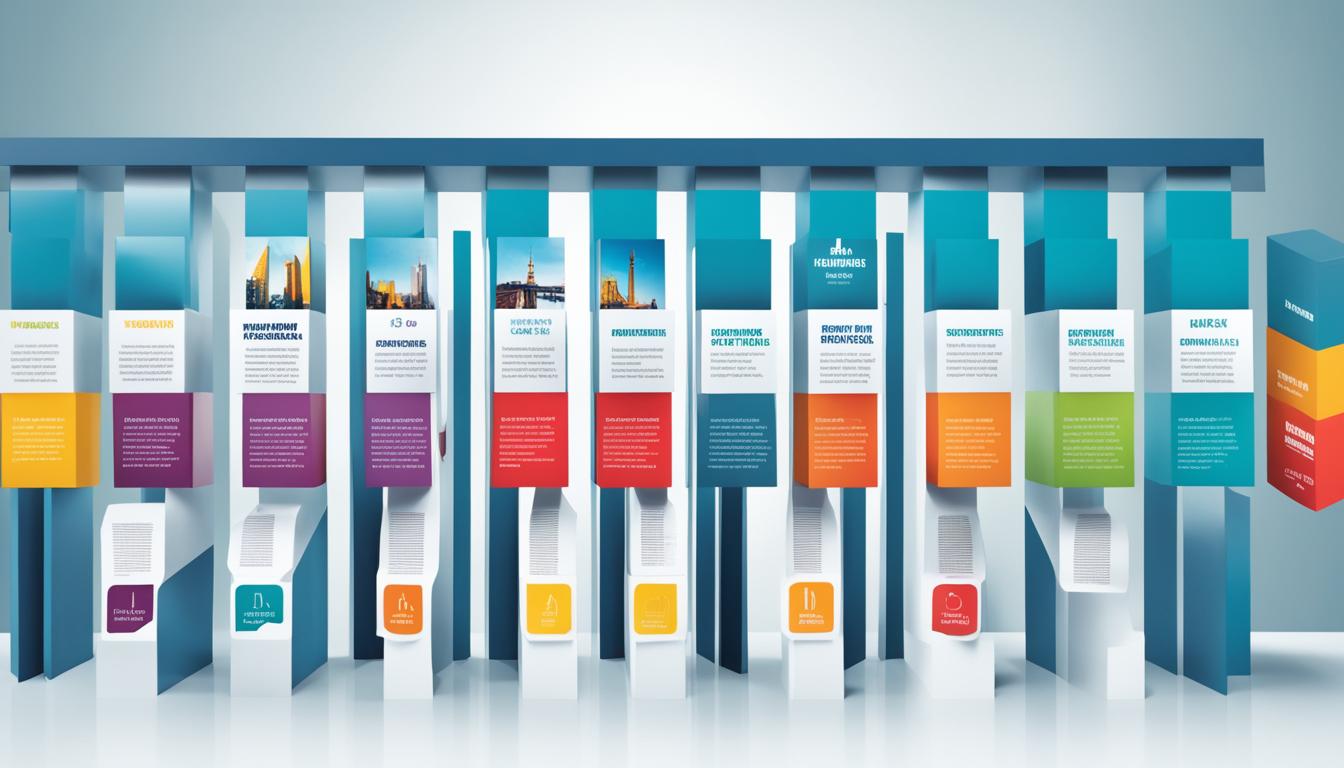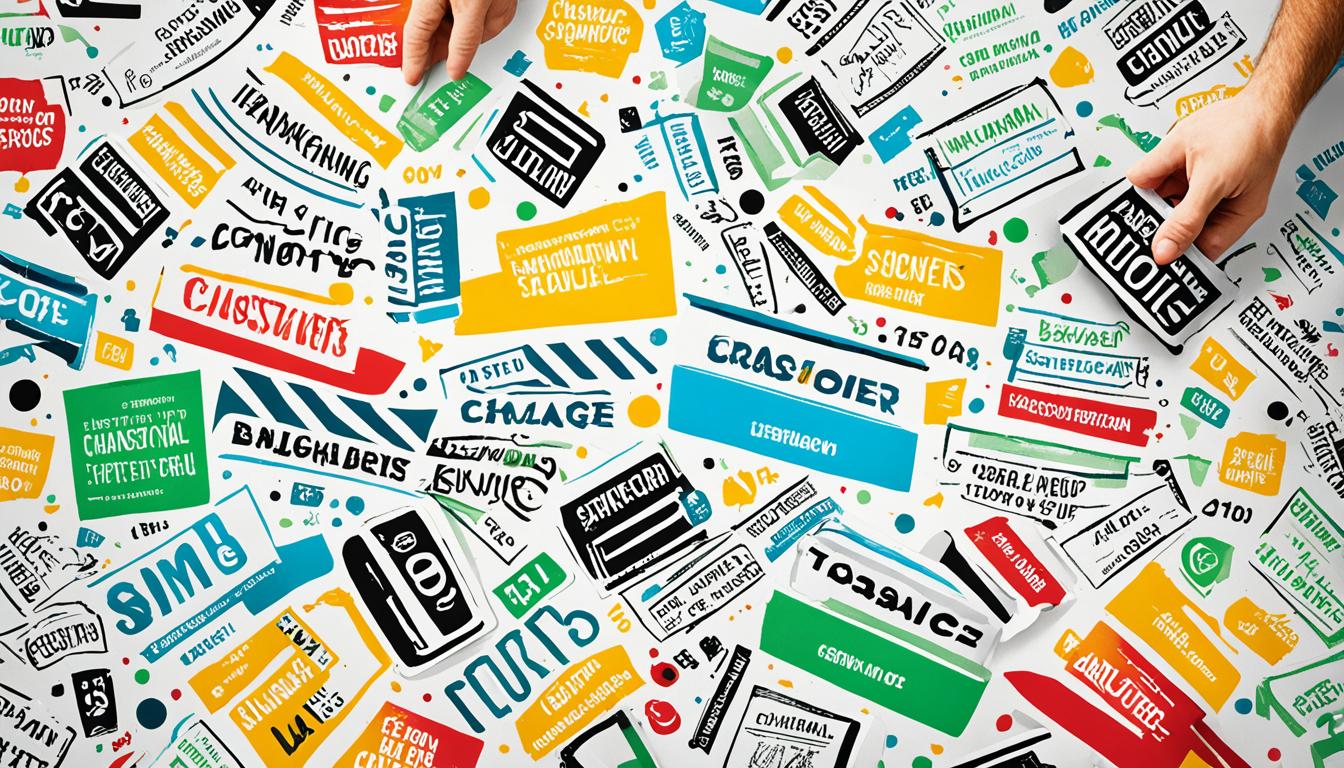Billboard advertising is a cost-efficient and effective form of outdoor advertising that will continue to be relevant in 2024. With its visual branding and ability to enhance brand visibility, billboard marketing can help you reach your target audience. In this complete guide, we will walk you through all the aspects of an effective billboard marketing strategy, from understanding the cost of billboards to the importance of location and messaging.
Key Takeaways:
- A billboard marketing strategy is a cost-efficient and effective way to enhance brand visibility and reach a targeted audience.
- Consider the cost of billboards, including the duration of the campaign, location, and size, when planning your strategy.
- Plan and produce your billboard advertisements with consideration for lead time, billboard type, and any time elements.
- Choose the right billboard location by analyzing demographics and nearby businesses or attractions that align with your target audience.
- Craft effective messaging that aligns with your brand identity and resonates with your target customers.
The Cost of Billboard Advertising
When developing a comprehensive billboard marketing strategy, one crucial factor to consider is the cost of advertising. The cost of billboards is measured in terms of the CPM (cost per thousand impressions) and is often significantly lower compared to other forms of media, making it a cost-efficient option for reaching a wide audience.
The cost of billboards can vary depending on several factors:
- Duration of the Campaign: The length of time you plan to run your billboard campaign can impact the overall cost. Longer campaigns often come with more competitive pricing options, allowing you to reach the desired number of impressions while optimizing your budget.
- Location of the Billboard: The location of the billboard plays a significant role in determining its cost. High-traffic areas and prime locations typically command a higher price due to increased visibility and exposure to a larger audience.
- Size and Type of the Billboard: The size and type of billboard you choose can influence the cost. Larger billboards with more expansive display areas tend to have higher rates. Additionally, digital billboards may offer more flexibility but can come at a higher price compared to traditional static billboards.
To ensure you allocate the appropriate budget for your billboard marketing strategy, it’s essential to conduct thorough research and evaluate various vendor options. Consider their reputation, track record, and feedback from previous clients to select a reliable vendor that offers the best value for your investment.
Cost Comparison: Billboard Advertising vs. Other Media
To illustrate the cost-effectiveness of billboard advertising, let’s compare it to other media channels based on CPM.
| Media Channel | CPM |
|---|---|
| Billboard | $20 – $40 |
| Television | $9 – $55 |
| Radio | $10 – $30 |
| Newspaper | $12 – $29 |
| Online Display Ads | $2 – $12 |
As evident from the comparison above, billboard advertising offers a competitive CPM range, making it an attractive option for marketers seeking to maximize their reach within a specific budget.
Planning and Production
Planning and production are crucial elements in the development of a successful billboard marketing strategy. Effective planning involves considering various factors, including the production lead time, the choice between digital or static billboards, the production of a vinyl wrap for static billboards, and any time elements that may impact the scheduling and production process.
When it comes to lead time, it’s essential to account for the time required to book the billboard space, create the advertising creative, and ensure timely installation. This planning phase helps to ensure a smooth and well-executed campaign.
One important decision to make is whether to opt for a digital or static billboard. Digital billboards offer flexibility in terms of changing ads and targeting specific times of the day, while static billboards provide a large format and can be more cost-effective in certain locations.
If you choose a static billboard, the production process involves creating a vinyl wrap that will be applied to the billboard. This vinyl wrap contains the advertising message and graphics and helps to enhance the visual impact of the billboard. The production of the vinyl wrap should be factored into the overall planning and production timeline.
It’s also important to consider any time elements in your advertising messaging that may affect the production process. For example, if your campaign is focused on a specific event or time-limited offer, you’ll need to ensure that the production can be completed in time for the campaign launch.
In summary, thorough planning and production management are essential components of a successful billboard marketing strategy. By considering the production lead time, choosing between digital and static billboards, addressing the production of vinyl wraps for static billboards, and accounting for any time elements, you can ensure a well-executed campaign that effectively reaches your target audience.
Choosing the Right Location
The success of your billboard marketing strategy relies heavily on selecting the right location for your billboards. By strategically placing your billboards in locations that align with your target audience, you can maximize the impact of your advertising efforts.
When choosing the location for your billboards, it is essential to analyze the demographics of the area. Understanding your target audience’s characteristics and preferences will help you determine which locations will be most effective in reaching them. Consider factors such as age, gender, income level, and interests to ensure that your billboards are placed in areas where your target audience is likely to be.
Apart from demographics, it is also crucial to consider the businesses and attractions in the vicinity of your chosen location. Look for businesses that complement your products or services, as their customer base may overlap with your target audience. Additionally, consider attractions or popular landmarks that attract a large number of visitors who align with your target audience.
To gain a better understanding of the location’s suitability, it is highly recommended to physically visit the potential billboard locations. By doing so, you can assess any potential obstructions that may hinder visibility. This hands-on approach allows you to make informed decisions about the placement of your billboards and ensure maximum exposure.
Ultimately, selecting the right locations for your billboards is an essential aspect of your overall location-based marketing strategy. By considering the demographics, nearby businesses and attractions, and physically visiting the locations, you can strategically position your billboards to effectively reach your target audience.
Crafting Effective Messaging
Crafting effective messaging is a critical element of a successful billboard marketing strategy. Your billboard messaging plays a crucial role in capturing the attention of your target audience and conveying your brand identity. To make the most impact, your message should align with your brand values and evoke the desired emotional response or feeling from viewers.
When it comes to billboard messaging, simplicity is key. Viewers often have only a few seconds to absorb the message, so keeping it short and concise is essential. Focus on delivering your core message in a clear and straightforward manner.
Another important consideration is the voice and tone of your messaging. Your voice and tone should resonate with your target customers, aligning with their preferences and values. Whether your brand is playful and lighthearted or professional and authoritative, it’s important to maintain consistency throughout your billboard messaging.
Remember, your billboard is just one touchpoint in your overall marketing strategy. It should complement your other marketing efforts while showcasing a clear and memorable message.
Setting Goals for Your Billboard
Setting clear and measurable goals is crucial to the success of your billboard campaign. Whether your objective is to drive sales or increase brand awareness, defining your goals will help you determine the effectiveness of your campaign and measure its impact. In this section, we will explore the different aspects of setting goals for your billboard marketing strategy.
Identify Your Billboard Goals
The first step in setting goals for your billboard campaign is to identify what you want to achieve. Are you looking to increase sales, generate leads, raise brand awareness, or promote a specific product or service? By clarifying your objectives, you can direct your efforts toward achieving meaningful outcomes.
Determine Measurement Metrics
To track the success of your billboard campaign, it is important to determine the right metrics to measure its performance. These measurement metrics will depend on your goals. For example, if your goal is to drive sales, you may want to track the number of conversions or revenue generated from the campaign. If your goal is brand awareness, you can monitor metrics such as social media mentions, website traffic, or brand recognition surveys.
Consider Standalone or Integrated Campaigns
When setting goals for your billboard campaign, consider whether it will be a standalone initiative or part of a larger integrated marketing campaign. A standalone campaign focuses solely on the billboard, while an integrated campaign combines multiple marketing channels to create a comprehensive strategy. The choice between the two depends on your marketing objectives, budget, and target audience.
By setting clear goals, determining the right measurement metrics, and deciding on a standalone or integrated approach, you can ensure that your billboard campaign is effective and aligns with your overall marketing strategy.
Example of Billboard Goals and Measurement Metrics
To provide a better understanding, consider the following example of billboard goals and measurement metrics:
| Billboard Goals | Measurement Metrics |
|---|---|
| Increase website traffic | – Number of website visits from unique URLs displayed on the billboard – Website bounce rate – Conversion rate of billboard-driven traffic |
| Raise brand awareness | – Social media mentions and engagements – Brand recognition surveys – Increase in website traffic from the target audience |
| Drive sales | – Number of conversions (purchases or leads) – Revenue generated from billboard-driven sales – Coupon code redemptions |
Remember that these goals and measurement metrics should be customized based on your specific campaign objectives and target audience. By tracking these metrics, you can evaluate the success of your billboard marketing campaign and make data-driven decisions for future campaigns.
Designing an Impactful Billboard
When it comes to billboard advertising, capturing viewers’ attention in a matter of seconds is crucial. To ensure your billboard stands out from the crowd, creative design plays a pivotal role. By incorporating eye-catching visuals, bold colors, and a clear message, you can create a billboard that demands attention.
One effective strategy is to include a call to action in your design. This encourages viewers to take immediate action, such as visiting your website or making a purchase. Remember to keep the word count to a minimum, ideally using fewer than six words, to ensure that your message is concise and impactful.
In addition to the visual elements, consider the readability of your billboard. Make sure that the font size and style are easily readable from a distance to ensure that your message reaches as many viewers as possible.
Furthermore, in today’s digital age, it’s essential to provide viewers with avenues for further engagement. Consider incorporating a QR code or URL on your billboard, which viewers can scan or visit to learn more about your brand or access exclusive offers.
By focusing on creative design, incorporating a call to action, ensuring readability, and incorporating interactive elements such as a QR code or URL, you can design an impactful billboard that leaves a lasting impression on your target audience.
Digital Billboards vs Traditional Billboards
When it comes to choosing between digital billboards and traditional billboards, there is no definitive answer as to which is better. Both types have their own unique advantages and considerations that should be taken into account when selecting the right option for your marketing strategy.
The Upsides of Digital Billboards
Digital billboards offer a range of benefits that make them an attractive choice for advertisers. One of the main advantages is their flexibility. Unlike traditional billboards, digital billboards allow for dynamic content that can be changed on demand. This means you can update your ads frequently, target specific times of the day, or even run multiple campaigns simultaneously. It provides advertisers with the ability to showcase their content in a more engaging and time-sensitive manner.
The Benefits of Traditional Billboards
Traditional billboards, on the other hand, offer their own unique upsides. They provide a large format that can’t be overlooked and can be highly impactful, especially in high-traffic areas. Traditional billboards also tend to be more cost-effective in certain locations, making them an economical choice for advertisers with budget constraints.
When deciding between digital and traditional billboards, it’s important to evaluate your specific marketing goals and needs. Consider factors such as target audience, budget, and the message you want to convey. Evaluating the advantages and limitations of each option will help you make an informed decision.
| Advantages | Digital Billboards | Traditional Billboards |
|---|---|---|
| Flexibility | Ads can be changed frequently | Large format that can’t be overlooked |
| Targeting | Ability to target specific times of the day | High-traffic areas reach a broad audience |
| Cost | Variety of price options available | Can be more cost-effective in certain locations |
Ultimately, the key is to choose the option that aligns with your overall marketing goals and effectively reaches your target audience. Both digital and traditional billboards have their place in a well-rounded marketing strategy, and leveraging the strengths of each type can maximize the impact of your advertising efforts.
Conclusion
Billboard marketing continues to be a relevant and effective strategy in 2024. By considering the cost, planning, location, messaging, goals, design, and type of billboard, you can create a successful billboard marketing strategy that elevates your brand’s visibility and reaches your target audience. Whether you choose digital or traditional billboards, the key is to capture viewers’ attention, convey your message effectively, and track the results to make informed decisions for future campaigns.






